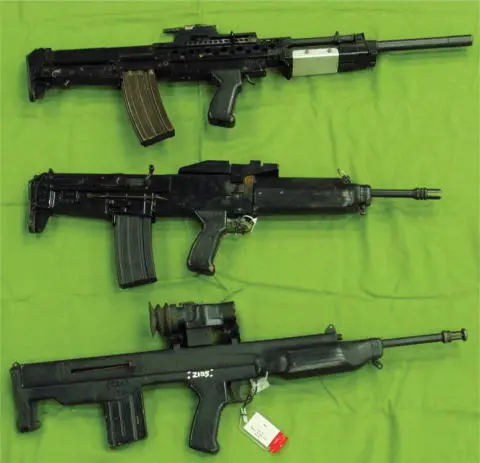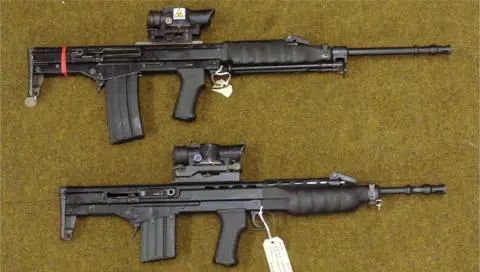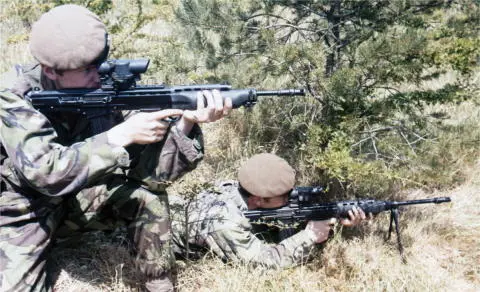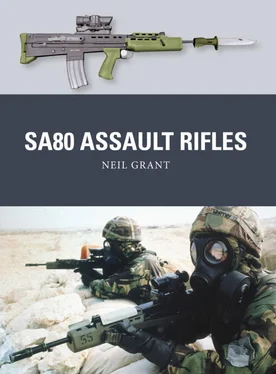Although the bullpup rifles looked radical from the outside, the mechanism bore a strong resemblance to that of the Armalite AR-18. Indeed, some of the internal components seemed to be straight copies, or even re-used Armalite components, leading to assertions that the design was ‘just a bull-pupped AR18’.

A wood-and-metal mock-up to demonstrate what a potential bullpup individual weapon might look like (bottom); and two conventional weapons – an Armalite AR-18 (middle) and Stoner 63 (top) – converted into bullpup configuration during the feasibility study. (Author’s photograph, © Royal Armouries PR.10084, PR.5350, PR.5345)
The feasibility study concluded that the 4.85mm ammunition exceeded the 300m effective range requirement set out for the IW, and just met the 600m requirement for the LSW. Based on these results, the MoD formalized GST 3518 as a General Staff Requirement (GSR) in 1974, defining the characteristics of the required weapon system. The new IW would replace the L1A1 SLR and L2A3 Sterling SMG, while the LSW would replace the L4A4 Bren and L7A1 GPMG. The new weapons would be shorter, lighter and handier, and their reduced ranges would not be a tactical disadvantage in the battle scenarios envisaged. They would simplify training, and reduce the soldier’s load. The GSR noted that the LSW only had a limited sustained-fire capability; but any significant increase in rate of fire would require belt feed, which was incompatible with the requirement to use the same magazine as the rifle. The possibility of providing the LSW with a quick-change barrel to improve sustained-fire capability was noted, but not actioned.
The AR-18
The 5.56mm Armalite AR-15 rifle was a radical design when it was adopted by the US Army as the M16 from 1965, but it required advanced materials and relatively complex tooling to produce. Armalite therefore developed the AR-18 as a simpler weapon, made mostly from steel stampings. It was a low-cost design intended for production in less-developed countries that wanted to adopt the 5.56mm cartridge, but had a more limited industrial base.
The AR-18 was a selective-fire 5.56mm rifle like the M16, but it used a conventional gas piston rather than M16-style direct gas impingement, in which propellant gas acts directly on the bolt carrier. Whereas the M16’s buffer mechanism protrudes into the butt and prevents use of a folding stock, the AR-18’s mechanism was fully contained in the receiver, allowing a side-folding stock to be fitted as standard.
The AR-18 was tested by the US Army in 1964 and the British Army in 1966. These trials found that its functioning was rather dependent on ammunition quality; and that although the basic design was sound, its reliability would need to be improved before it was acceptable as a service rifle. In particular, the British felt it performed poorly in the mud and sand tests.
Armalite produced only a few AR-18s itself, but licensed production to a Japanese company during 1970–74, and then to the Sterling Armaments Company in Britain during 1975–83. The Sterling factory was practically on RSAF Enfield’s doorstep, and RSAF engineers visited several times to view the AR-18 production line. Although never adopted by any army, a number of AR-18s found their way into the hands of Provisional Irish Republican Army terrorists during ‘the Troubles’ in Northern Ireland.
A 5.56mm Armalite AR-18 rifle with telescopic sight. (Courtesy Rock Island Auction Company)
THE IMPROVED ‘O’-SERIES PROTOTYPES (1975–76)
RSAF Enfield now began to develop and improve the initial prototype weapons, intending to have refined weapons ready by the NATO ammunition trials, scheduled for 1977. The first phase involved construction of another 12 prototypes, known as the ‘O’ series since their serial numbers began with weapon 01. Although these were similar to the previous ‘Double O’ series, detailed differences included a redesigned trigger and pistol grip, and repositioning of the sling-attachment points to the top of the weapon to allow it to be carried in what the designers termed a ‘handbag style’. The flash eliminator was modified to allow the weapon to fire NATO-standard 22mm rifle grenades, and the magazine release was moved from the right side of the body to the left – something that would cause problems later. Meanwhile, the selector switch was replaced by a rotary type with only two positions: single shot and automatic; the three-round-burst function of the ‘Double O’-series weapons disappeared.
Of the 12 ‘O’ prototypes, six were standard IWs, five of which were configured for right-handed use and one for left-handed use. Two extra IWs were built, one with flip-up emergency sights in case the SUSAT optical sight unit failed or was damaged, and the other with a stabilizing monopod beneath the barrel. Four LSW prototypes were constructed, two of which were right-handed models and one left-handed, all firing from closed bolt on single-shot and open bolt on automatic. The last of the four LSWs (also the twelfth and final ‘O’ prototype) was fitted with a quick-change barrel for improved sustained-fire performance, and a muzzle brake to reduce recoil rather than the standard flash eliminator. These modifications were rejected, however, since they increased both cost and weight while decreasing commonality with the IW – and commonality was a major selling point of the system. The improvement in sustained-fire capability was also relatively small, since the weapon remained magazine (rather than belt) fed.

Prototypes of the XL64 IW (below, with 20-round magazine) and XL65 LSW (above, with 30-round magazine). Note the bipod attachment halfway down the barrel on the LSW, and the SLR-style magazine release catch immediately behind the magazine well, rather than on the side. (Author’s Collection)

A publicity photo of the XL64E5 IW and XL65E4 LSW experimental weapons, June 1976. Note that the bipod of the LSW is attached much closer to the handguard than on the production LSW. (Cody Images)
The Enfield Weapon System was unveiled to the press in June 1976, ahead of the NATO ammunition trials scheduled for the following year. The publicity material implicitly assumed that it would become the British Army’s next infantry weapon system in due course, even though no formal acceptance – nor any trials – had taken place, and only a small number of essentially hand-built prototypes had actually been produced. The publicity material highlighted the innovative design of the Enfield weapons. It also emphasized the reduction in length and weight compared to the SLR and GPMG they would replace, while stating that although the detailed performance was ‘classified’, they were ‘at least as effective as the current 7.62mm weapons over normal ranges and conditions’ (quoted in Raw 2003: 37). Even the two photographs included in the press pack were carefully crafted to add to the image of modernity. In each case, the soldier holding the new weapon wore the latest equipment, including the new ballistic helmet, while his counterpart with SLR or GPMG was dressed in dated equipment and old-fashioned steel helmet.
Читать дальше
















